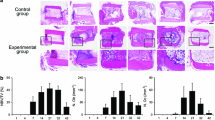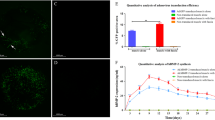Abstract
Background
To test whether autologous transplantation of bone marrow-derived mesenchymal stem cells (BM-MSCs) expressing human bone morphogenic protein-2 (hBMP-2) can produce bone in rabbit leg muscles.
Materials and Methods
MSCs were isolated from BM of the iliac crest of rabbits and then infected with lentiviral vectors (LVs) bearing hBMP-2 and green fluorescent protein under the control of the cytomegalovirus (immediate early promoter). Differentiation of transduced MSCs to osteoblasts in vitro was evaluated with an alkaline phosphatase activity assay and immuohistochemistry against osteoblast specific markers. MSCs expressing hBMP-2 were placed in an absorbable gelatin sponge, which was then transplanted into the gastrocnemius of rabbits from which MSCs were isolated. Bone formation was examined by X-ray and histological analysis.
Results
LVs efficiently mediated hBMP-2 gene expression in rabbit BM-MSCs. Ectopic expression of hBMP in these MSCs induced osteoblastic differentiation in vitro. Bone was formed after the MSCs expressing hBMP-2 were transplanted into rabbit muscles. Conclusion: Ectopic expression of hBMP-2 in rabbit MSCs induces them to differentiate into osteoblasts in vitro and to form a bone in vivo.
Similar content being viewed by others
References
Quinonez R, Sutton RE. Lentiviral vectors for gene delivery into cells. DNA Cell Biol 2002;21:937–51.
Gelse K, Schneider H. Ex vivo gene therapy approaches to cartilage repair. Adv Drug Deliv Rev 2006;58:259–84.
Løken S, Jakobsen RB, Arøen A, Heir S, Shahdadfar A, Brinchmann JE, et al. Bone marrow mesenchymal stem cells in a hyaluronan scaffold for treatment of an osteochondral defect in a rabbit model. Knee Surg Sports Traumatol Arthrosc 2008;16:896–903.
Yanoso-Scholl L, Jacobson JA, Bradica G, Lerner AL, O’Keefe RJ, Schwarz EM, et al. Evaluation of dense polylactic acid/ beta-tricalcium phosphate scaffolds for bone tissue engineering. J Biomed Mater Res A 2010;95:717–26.
Zuk PA, Zhu M, Mizuno H, Huang J, Futrell JW, Katz AJ, et al. Multilineage cells from human adipose tissue: Implications for cell-based therapies. Tissue Eng 2001;7:211–28.
Limbert C, Ebert R, Schilling T, Path G, Benisch P, Klein-Hitpass L, et al. Functional signature of human islet-derived precursor cells compared to bone marrow-derived mesenchymal stem cells. Stem Cells Dev 2010;19:679–91.
In ‘t Anker PS, Scherjon SA, Kleijburg-van der Keur C, de Groot-Swings GM, Claas FH, Fibbe WE, et al. Isolation of mesenchymal stem cells of fetal or maternal origin from human placenta. Stem Cells 2004;22:1338–45.
Caplan AI. Adult mesenchymal stem cells for tissue engineering versus regenerative medicine. J Cell Physiol 2007;213:341–7.
Li F, Wang X, Niyibizi C. Bone marrow stromal cells contribute to bone formation following infusion into femoral cavities of a mouse model of osteogenesis imperfecta. Bone 2010;47:546–55.
Izuta Y, Ochi M, Adachi N, Deie M, Yamasaki T, Shinomiya R. Meniscal repair using bone marrow-derived mesenchymal stem cells: Experimental study using green fluorescent protein transgenic rats. Knee 2005;12:217–23.
Pittenger MF, Mackay AM, Beck SC, Jaiswal RK, Douglas R, Mosca JD, et al. Multilineage potential of adult human mesenchymal stem cells. Science 1999;284:143–7.
Shafiee A, Seyedjafari E, Soleimani M, Ahmadbeigi N, Dinarvand P, Ghaemi N. A comparison between osteogenic differentiation of human unrestricted somatic stem cells and mesenchymal stem cells from bone marrow and adipose tissue. Biotechnol Lett 2011;33:1257–64.
Kadiyala S, Young RG, Thiede MA, Bruder SP. Culture expanded canine mesenchymal stem cells possess osteochondrogenic potential in vivo and in vitro. Cell Transplant 1997;6:125–34.
Kirker-Head CA. Potential applications and delivery strategies for bone morphogenetic proteins. Adv Drug Deliv Rev 2000;43:65–92.
Kalwitz G, Endres M, Neumann K, Skriner K, Ringe J, Sezer O, et al. Gene expression profile of adult human bone marrow-derived mesenchymal stem cells stimulated by the chemokine CXCL7. Int J Biochem Cell Biol 2009;41:649–58.
Valenti MT, Dalle Carbonare L, Donatelli L, Bertoldo F, Zanatta M, Lo Cascio V. Gene expression analysis in osteoblastic differentiation from peripheral blood mesenchymal stem cells. Bone 2008;43:1084–92.
Bosnakovski D, Mizuno M, Kim G, Takagi S, Okumura M, Fujinaga T. Chondrogenic differentiation of bovine bone marrow mesenchymal stem cells (MSCs) in different hydrogels: Influence of collagen type II extracellular matrix on MSC chondrogenesis. Biotechnol Bioeng 2006;93:1152–63.
Meinel L, Hofmann S, Betz O, Fajardo R, Merkle HP, Langer R, et al. Osteogenesis by human mesenchymal stem cells cultured on silk biomaterials: Comparison of adenovirus mediated gene transfer and protein delivery of BMP-2. Biomaterials 2006;27:4993–5002.
Cheng SL, Lou J, Wright NM, Lai CF, Avioli LV, Riew KD. in vitro and in vivo induction of bone formation using a recombinant adenoviral vector carrying the human BMP-2 gene. Calcif Tissue Int 2001;68:87–94.
Sugiyama O, An DS, Kung SP, Feeley BT, Gamradt S, Liu NQ, et al. Lentivirus-mediated gene transfer induces long term transgene expression of BMP-2 in vitro and new bone formation in vivo. Mol Ther 2005;11:390–8.
Shi ZB, Wang KZ. Effects of recombinant adeno-associated viral vectors on angiopoiesis and osteogenesis in cultured rabbit bone marrow stem cells via co-expressing hVEGF and hBMP genes: A preliminary study in vitro. Tissue Cell 2010;42:314–21.
Logan AC, Lutzko C, Kohn DB. Advances in lentiviral vector design for gene-modification of hematopoietic stem cells. Curr Opin Biotechnol 2002;13:429–36.
Iwai R, Fujiwara M, Wakitani S, Takagi M. Ex vivo cartilage defect model for the evaluation of cartilage regeneration using mesenchymal stem cells. J Biosci Bioeng 2011;111:357–64.
Azzouz M, Kingsman SM, Mazarakis ND. Lentiviral vectors for treating and modeling human CNS disorders. J Gene Med 2004;6:951–62.
Huang J, Zhang L, Chu B, Peng X, Tang S. Repair of bone defect in caprine tibia using a laminated scaffold with bone marrow stromal cells loaded poly (L-lactic acid)/ß-tricalcium phosphate. Artif Organs 2011;35:49–57.
Terella A, Mariner P, Brown N, Anseth K, Streubel SO. Repair of a calvarial defect with biofactor and stem cell-embedded polyethylene glycol scaffold. Arch Facial Plast Surg 2010;12:166–71.
Kim J, Kim IS, Cho TH, Lee KB, Hwang SJ, Tae G, et al. Bone regeneration using hyaluronic acid-based hydrogel with bone morphogenic protein-2 and human mesenchymal stem cells. Biomaterials 2007;28:1830–7.
Grgurevic L, Macek B, Mercep M, Jelic M, Smoljanovic T, Erjavec I, et al. Bone morphogenetic protein (BMP) 1-3 enhances bone repair. Biochem Biophys Res Commun 2011;408:25–31.
Inagaki N, Narushima K, Lim SK. Effects of aromatic groups in polymer chains on plasma surface modification. J Appl Polym Sci 2003;89:96–103.
Tjia JS, Aneskievich BJ, Moghe PV. Substrate-adsorbed collagen and cell secreted fibronectin concertedly induce cell migration on poly (lactide-glycolide) substrates. Biomaterials 1999;20:2223–33.
Guidance Suggestions for the Care and Use of Laboratory Animals The Ministry of Science and Technology of the People’s Republic of China. [Last accessed on 2006 Sep 30].
Chen F, Chen S, Tao K, Feng X, Liu Y, Lei D, et al. Marrow-derived osteoblasts seeded into porous natural coral to prefabricate a vascularised bone graft in the shape of a human mandibular ramus: Experimental study in rabbits. Br J Oral Maxillofac Surg 2004;42:532–7.
Sena-Esteves M, Tebbets JC, Steffens S, Crombleholme T, Flake AW. Optimized large-scale production of high titer lentivirus vector pseudotypes. J Virol Methods 2004;122:131–9.
Hirata K, Tsukazaki T, Kadowaki A, Furukawa K, Shibata Y, Moriishi T, et al. Transplantation of skin fibroblasts expressing BMP-2 promotes bone repair more effectively than those expressing Runx2. Bone 2003;32:502–12.
de Girolamo L, Bertolini G, Cervellin M, Sozzi G, Volpi P. Treatment of chondral defects of the knee with one step matrix-assisted technique enhanced by autologous concentrated bone marrow: in vitro characterisation of mesenchymal stem cells from iliac crest and subchondral bone. Injury 2010;41:1172–7.
Musgrave DS, Bosch P, Lee JY, Pelinkovic D, Ghivizzani SC, Whalen J, et al. Ex vivo gene therapy to produce bone using different cell types. Clin Orthop Relat Res 2000;378:290–305.
Sacchetti B, Funari A, Michienzi S, Di Cesare S, Piersanti S, Saggio I, et al. Self-renewing osteoprogenitors in bone marrow sinusoids can organize a hematopoietic microenvironment. Cell 2007;131:324–36.
Sutherland MS, Rao LG, Muzaffar SA, Wylie JN, Wong MM, McBroom RJ, et al. Age-dependent expression of osteoblastic phenotypic markers in normal human osteoblasts cultured long term in the presence of dexamethasone. Osteoporos Int 1995;5:335–43.
Kawaguchi T, Yamaguchi A, Komaki M, Abe E, Takahashi N, Ikeda T, et al. bone morphogenetic protein-2 converts the differentiation pathway of C2C 12 myoblasts into the osteoblast lineage. J Cell Biol 1994;127:1755–66.
Chuang CK, Sung LY, Hwang SM, Lo WH, Chen HC, Hu YC. Baculovirus as a new gene delivery vector for stem cell engineering and bone tissue engineering. Gene Ther 2007;14:1417–24.
Ferreira E, Potier E, Vaudin P, Oudina K, Bensidhoum M, Logeart-Avramoglou D, et al. Sustained and promoter dependent bone morphogenetic protein expression by rat mesenchymal stem cells after BMP-2 transgene electrotransfer. Eur Cell Mater 2012;24:18–28.
Wegman F, Bijenhof A, Schuijff L, Oner FC, Dhert WJ, Alblas J. Osteogenic differentiation as a result of BMP-2 plasmid DNA based gene therapy in vitro and in vivo. Eur Cell Mater 2011;21:230–42.
Hamm A, Krott N, Breibach I, Blindt R, Bosserhoff AK. Efficient transfection method for primary cells. Tissue Eng 2002;8:235–45.
Zaragosi LE, Billon N, Ailhaud G, Dani C. Nucleofection is a valuable transfection method for transient and stable transgene expression in adipose tissue-derived stem cells. Stem Cells 2007;25:790–7.
Sun Y, Finne-Wistrand A, Albertsson AC, Xing Z, Mustafa K, Hendrikson WJ, et al. Degradable amorphous scaffolds with enhanced mechanical properties and homogeneous cell distribution produced by a three-dimensional fiber deposition method. J Biomed Mater Res A 2012;100:2739–49.
Lü K, Zeng D, Zhang W, Xia L, Xu L, Jiang X, et al. Ectopic study of calcium phosphate cement seeded with pBMP-2 modified canine bMSCs mediated by a nonviral PEI derivative. Cell Biol Int 2012;36:119–28.
Fujita N, Matsushita T, Ishida K, Sasaki K, Kubo S, Matsumoto T, et al. An analysis of bone regeneration at a segmental bone defect by controlled release of bone morphogenetic protein 2 from a biodegradable sponge composed of gelatin and ß-tricalcium phosphate. J Tissue Eng Regen Med 2012;6:291–8.
Mehanna R, Koo S, Kim DM. Recombinant human bone morphogenetic protein 2 in lateral ridge augmentation. Int J Periodontics Restorative Dent 2013;33:97–102.
Author information
Authors and Affiliations
Corresponding author
Rights and permissions
About this article
Cite this article
Wei, L., Lei, GH., Yi, HW. et al. Bone formation in rabbit’s leg muscle after autologous transplantation of bone marrow-derived mesenchymal stem cells expressing human bone morphogenic protein-2. IJOO 48, 347–353 (2014). https://doi.org/10.4103/0019-5413.136208
Published:
Issue Date:
DOI: https://doi.org/10.4103/0019-5413.136208




